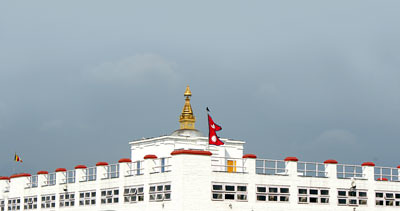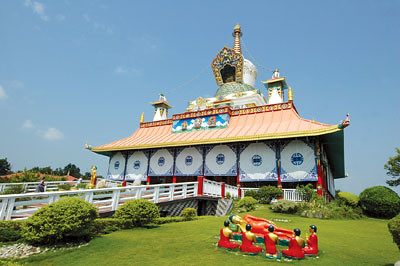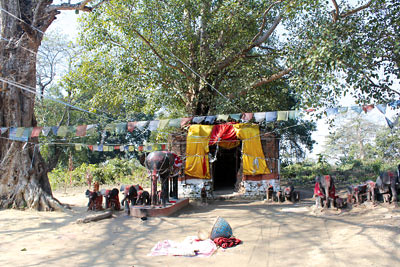Three things unite 26 million Nepalis like nothing else: MoMo, Mount Everest, and Lumbini

PICS: TRISHNA RANA
Three things unite 26 million Nepalis like nothing else: MoMo, Mount Everest, and Lumbini. Some of us take our national symbols so seriously we create Facebook pages declaring that Buddha was born in Nepal.
But national symbols aside, Lumbini needs to be on every traveller’s bucket list. Located in Rupandehi district, barely 30 minutes from the Indian border, the city pulls in up to 700,000 pilgrims annually, pumping cash into the local economy.
A 10 hour ride on a rickety bus from Kathmandu (most tourist buses only go till Chitwan or Butwal) or a pleasant 30 minute flight to Bhairawa and then half an hour on a taxi will take you into Lumbini. While village walks, bird-watching, and a day trip to neighbouring Tilaurakot in Kapilvastu are some of the highlights, it’s the nativity site and the Lumbini development zone that are the main attractions.
Spread across 777 hectares with the Maya Devi Temple on the southern end and the Peace Pagoda on the northern and dozens of international monasteries on either side, Lumbini today is an international hub that brings together people of different beliefs, colour, ethnicity, and nationality under one garden.
On any given day, you will find eager groups of students learning about the history of Buddhism, families from Sri Lanka taking a breather in the sacred garden, and pilgrims from south-east Asia who saved up for years for this trip happily snapping away.
The tour is best done on foot. Make sure you have an entire day (two days are ideal) to explore the nooks and corners of the garden as well as a visit to the museum. Or there are rickshaws on queue at the main bus stop gate and the gate at Mahilwar who will give you a four hour tour for Rs 400. Bikes are also available for rent ar Rs 100 an hour.
See in buzz:
Buddha's Maya
Sunflower Travellers Lodge and Restaurant
3 Fox
Maya Devi Temple
Before Lumbini was transformed into a spiritual Disneyland, it was the iconic white box flanked by a lone-standing pipal tree on one side and the Asokan pillar on the other that devotees and tourists from around the globe flocked to. Excavated in 1996 and rebuilt in 2002, today visitors can go inside to view the ‘marker stone’ denoting the exact spot of Gautam Buddha’s birth, the Maya Devi statue, and the excavations.
Next to the monument is the emerald green Puskarini or holy pond where Buddha is said to have had his first bath and surrounding it are more excavation sites and the lush sacred garden. Once you are done looking around, take a breather, admire the hundreds of prayer flags fluttering in the breeze, and absorb a moment of inner peace.
Great Lotus Stupa (Germany)

ANDREAS LEHNERT
The Great Lotus monastery dwarfs in comparison to the Chinese and Korean structures. However, the Germans show that size indeed does not matter. Built by the German Tara Foundation in 1999, this is by far the most elegant and impressive stupas out of the 20 or so in the area. Enclosed by a L-shaped pond, there is a sense of perfect harmony here provided by the seven-feet gigantic prayer wheels at four corners of the monastery. As you circle around the stupa you will see spectacular murals on the walls depicting Buddhist places of worship like Swayambhunath in Kathmandu. If you are lucky to make it here before noon (when the monastery closes for an hour for lunch), find yourself a spot outside the prayer hall, shut off your camera, and soak up the serenity as you listen to resident monks chant in unison.
Mahabodhi Society Monastery (South Korea)
The gigantic grey Korean structure easily towers above the rest and can be seen from a far distance. Still under construction, the three-storey monastery manages to awe visitors with its sheer size. Step inside the uncluttered prayer hall where you will find portraits and paintings of Korean spiritual leaders, light an oil lamp, and let the empty space help you clear your mind.
Tilaurakot
Perhaps one of the most neglected sites in the Lumbini circuit, Tilaurakot in Kapilvastu district was once the crowning glory of the Shakya dynasty. Today Buddhist devotees and tourists who have more than a night to spend at Lumbini venture out to observe the abandoned remains of the palace’s fortification wall.
The former palace ground is in an overgrown forest in the middle of nowhere. A huge pond and a Maya Devi temple guarded by elephants add to the eerie sense of calm you find here and although there is nothing much to do, all it takes is some imagination to transport you to 500 BC Nepal.
Although you can hire a taxi or van for the day, the best way to see the countryside is biking especially because the roads are so smooth and flat. The scenery alternates between endless mustard fields and busy bajars with several minarets and temples peppered in between. Take photos of boys playing cricket, old couples tending cattle, and families of three or four all squeezing on the back of a crumbling bike.

Those who are not in the healthiest shape or are looking for little more adventure, can hop on the back of a rickshaw. You will double your travel time, but won’t regret the decision. Stop for regular breaks, head into street-side tea shops for the sweetest cups of chiya you will ever taste, try a samosa, and listen to men engage in animated discussions about, you guessed it, local politics. The ride here is the best part of the journey.
Zhong Hua Buddhist Monastery (China)
You have seen it on TV: the sweeping roof with yellow glazed tiles, loping ridges decorated with a line of statues, and big, beautiful courtyards. But you’ve always wondered what the Forbidden City in Beijing might look like in real life. Here is your opportunity to explore traditional Chinese architecture and art without the visa hassles. Let laughing Buddha welcome you at the gate. Make sure you take your time to allow for a leisurely stroll around the monastery and admire the detailed handiwork of the artisans.
Peace Pagoda

ANDREAS LEHNERT
Built in 1993 by the Japanese, the pagoda is almost identical in architecture and design to the one in Pokhara. But surrounded by a sea of green, it is definitively more charming. Visit during the late afternoons when the warm orange sunshine falls directly on the gold plated Buddha making him almost come to life. On the periphery of the Lumbini zone, you can either start or end your journey here.
Two-way airfare to Bhairawa: Starts at Rs 6,300 (Nepalis) and $242 (others)
From Bhairawa airport to Lumbini:Rs 1,000
From Kathmandu to Lumbini: Rs 1,300 to Rs 1,800
Sakura Travels and Super Salina run three buses in the morning (between 7 to 8am) and two at night (between 7:30 and 8:00pm) which leave Kathmandu from Naya Bus Park at Gongabu. Microbuses also have direct routes to Lumbini.
2011 |
2012 |
| Total: 587,538 |
Total: 795,794 |
| Nepal: 395,570 |
Nepal: 539,210 |
| India: 63,709 |
India: 120,583 |
| Sri Lanka: 52,691 |
Sri Lanka: 52,671 |
| Thailand: 26,382 |
Thailand: 28,480 |
| Burma: 12,503 |
Burma: 17,595 |
| China: 8,961 |
China: 8,598 |
| Source: LUMBINI DEVELOPMENT TRUST |
Entry to Maya Devi Temple: Free (Nepalis), Rs 16 (Indians), Rs 200 (others)
Boat ride (one-way): Rs 45 (Nepalis), Rs 50 (others)